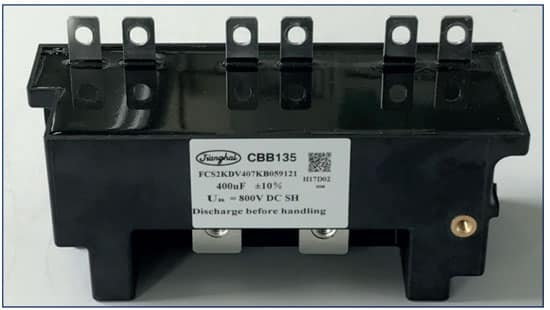In this article, Ole Bjørn, Jianghai Europe Managing Director, explains construction, advantages, applications of film capacitor modules and its suitability for modern power semiconductors requirements.
Efficient use of modern semiconductors in converters is almost impossible in a design with discrete components, as the distances between the components prevent the necessary low inductance coupling and increase ohmic losses as well as parasitic side effects.
FILM CAPACITOR MODULES: MINIMIZING INDUCTIVITIES AND OHMIC VALUES
Capacitors are used in a wide variety of types in DC-Link circuits of converters. ln the interest of ever increasing performance, driven by the desire for more efficiency and new semiconductor technologies, DC-Link voltages are rising to levels that cannot be reached by electrolytic capacitors.
DC-Link capacitors with plastic films, covering the voltage range from 1000V to 2000V, offer a solution.
Due to the high voltages and the steep switching edges and frequencies that modem semiconductors cause in power applications, rather complex DC-Link systems are usually necessary, consisting of:
- DC-Link capacitors as storage elements
- Snubber capacitors to protect against voltage spikes
- Busbar constructions (often expensive and complex due to high currents)
The construction in discrete structure results in high (parasitic) inductances and significant line losses due to the ohmic resistance of conducting tracks, soldered and screwed connections, that the excellent properties of modem semiconductors can only partially bring their power to the road.
DC-Link capacitor modules from Jianghai offer an elegant way to solve this issue.
FILM CAPACITOR MODULES: CUSTOMIZED DESIGN, SIGNIFICANTLY EASIER ASSEMBLY
ln addition to the advantage of custom-specific design and thus perfect adaptation to the topology of the application, developers can benefit from a significant simplification during assembly: The direct connection to semiconductors shortens the length of the current paths and thus minimizes parasitic inductance. Values in the single-digit nH range are possible, so there is no need for additional snubber capacitors. Continuous currents of many hundreds of amperes can be achieved through cooling surfaces or coupling to water cooling systems. The typical voltage range is from 400V to 2500V.
FILM CAPACITOR MODULES: CONSTRUCTION
The film capacitor module construction is shown in Figure 2. lnside the module is a frame structure in which several capacitor cells are usually connected in parallel. Depending on the design, copper bars are inserted as additional current paths.
The comparison between a cylindrical film capacitor and a module highlights the advantages of the module technology in lower ESR and higher ripple current – see Figure 3.
While modules have previously been found primarily in automotive applications, e.g., in on-board chargers, they are now increasingly finding their way into industrial applications. Quantities starting from 100 pieces can be realized.
SUMMARY
ln order to be able to use modem semiconductors optimally in terms of efficiency and cost, the use of capacitor modules is very advantageous.
Capacitor modules offer their users the design-options to realize the simplest and most powerful solution for their application.
